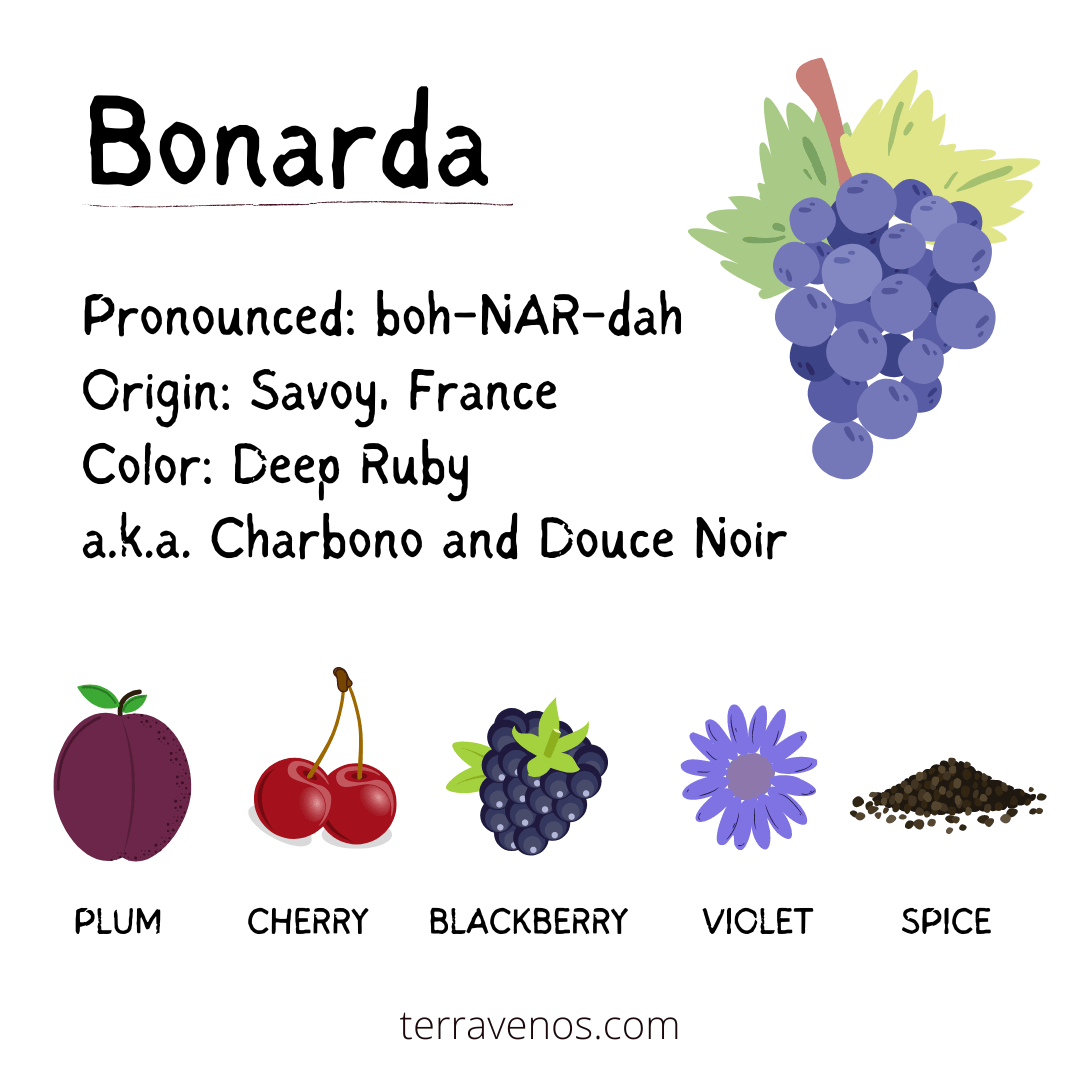
Pronunciation: boh-NAR-dah
Bonarda is a red wine grape originally from France (aka Douce Noir or Charbono). Today it’s widely planted in Argentina and makes a medium bodied dry red wine with cherry, plum, spice, and graphite.
Here’s what you need to know about Bonarda wine.
- What Kind of Wine Is Bonarda?
- Where Does Bonarda Come From?
- Bonarda vs. Malbec
- What Does Bonarda Taste Like?
- How to Serve Bonarda Wine
- Bonarda Food Pairing Suggestions
- Notable Bonarda Producers and Bottles to Try
- Bonarda in the Vineyard
- Bonarada Synonyms
- Final Thoughts – Bonarda as a Must-Try Red Wine Varietal
What Kind of Wine Is Bonarda?
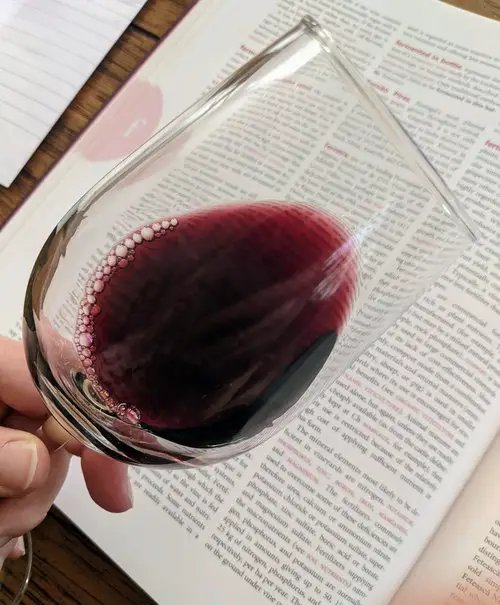
Bonarda is a medium-bodied red wine with moderate acidity, pronounced tannins, and medium alcohol content. It falls between lighter varietals like Gamay and fuller-bodied ones like Malbec in terms of style.
Where Does Bonarda Come From?
Douce Noir, also known as Bonarda, Corbeau, and Charbono, is a red wine grape variety originally from Savoy, France. It arrived in Savoy in the early 19th century and swiftly became the region’s most widely grown red grape. Today, this grape has gained popularity in Argentina, where it’s now the second most planted red grape variety after Malbec.
Bonarda in Argentina
Malbec may be the most widely-planted red grape in Argentina, but Bonarda enjoys popularity with the people. It’s a versatile, rich wine used in blends and single-varietal expressions. While it can be used for inexpensive table wines, it also crafts more complex wines worth your time that express terroir and the winemaking skill of the winemaker.
Bonarda In California
Douce Noir, also known as Charbono or Bonarda, holds a special spot in California winemaking. While relatively uncommon compared to other grape varieties, its loyal following appreciates its unique characteristics.
California’s warm-climate sites, along with significant diurnal temperature variations, create an ideal environment for cultivating Douce Noir, allowing the grapes to achieve optimum ripeness while retaining crucial acidity and preserving its distinct flavors.
Notably, some of the finest examples of Douce Noir wines in California are produced from old-vines, which add depth and complexity to the final product.
These old-vines contribute to the creation of dense, medium to full-bodied wines with a deep, inky purple color, while boasting delightful notes of black fruit, plum, and dried fig.
Look for Bonarda from these California AVAs:
- Napa Valley AVA
- Sonoma Valley AVA
- Mendocino County AVA
- Santa Barbara County AVA
- Paso Robles AVA
Helpful Tip: Here’s what you need to know about old vines.
Bonarda vs. Malbec
| Characteristics | Bonarda | Malbec |
|---|---|---|
| Hue | Deep ruby to purple | Deep purple to inky black |
| Color | Red | Red |
| Aromas | Blackberry, plum, cherry, spice | Black cherry, plum, tobacco, cocoa |
| Tannins | Moderate to high | High |
| Acid | Moderate | Moderate |
| Alcohol (%) | 13-15% | 13-15% |
| Body | Medium to full | Full |
| Intensity | Moderate to pronounced | Pronounced |
| Key Growing Regions | Argentina (Mendoza), Savoy (France), California | Argentina (Mendoza), France (Cahors) |
| Classic Pairings | Grilled meats, pasta with tomato sauce | Steak, barbecue, hearty stews |
| Price Range | $10-$25 | $15-$40 |
Bonarda and Malbec are two of Argentina’s most prominent red wine varietals, each offering unique attributes.
While both are rich and flavorful, they have distinct differences.
Bonarda tends to exhibit brighter acidity, higher tannins, and more red fruit flavors, making it a lively and vibrant choice. Malbec is known for its deep, dark fruit flavors, velvety texture, and plush tannins, offering a more opulent and robust experience. Both wines have their allure, but Bonarda’s lively nature sets it apart from the bolder, smoother Malbec.
Fun Wine Fact: Despite sharing a first name “Bonarda” Bonarda Piemontese grown in Italy doesn’t share any relation with the Bonarad from Savoy and Argentina.
What Does Bonarda Smell Like?
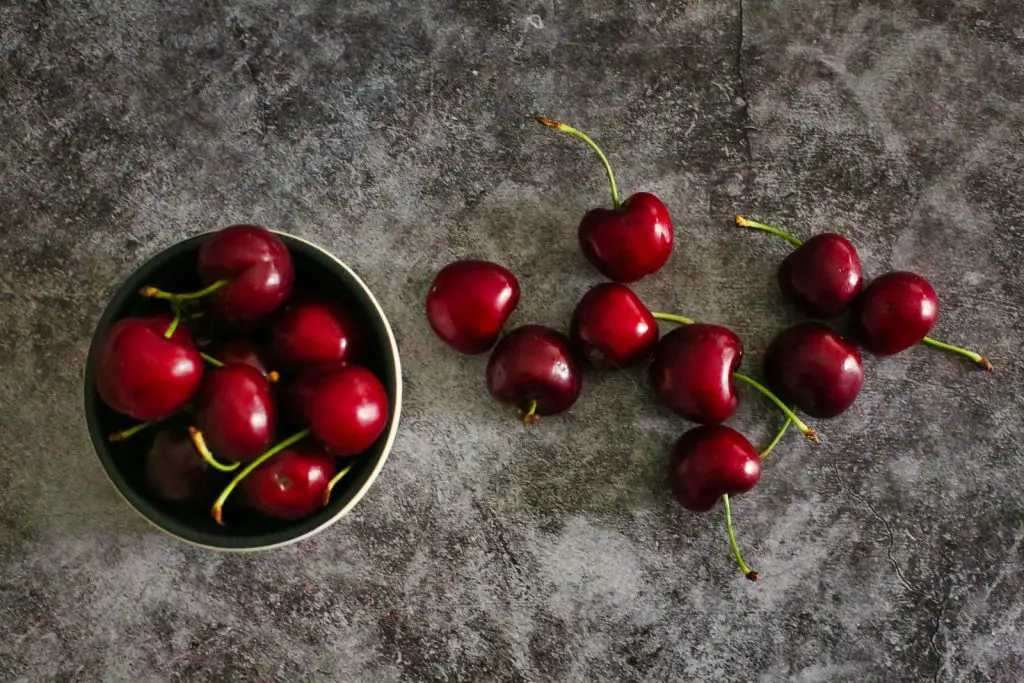
Bonarda features a captivating aroma profile, characterized by vibrant red fruit notes, such as black cherry, plum, and violet. In addition to the fruitiness, Bonarda often displays subtle hints of spice, like white pepper or clove, adding complexity to the overall bouquet.
What Does Bonarda Taste Like?
Bonarda/Douce Noir wines tend to have moderate alcohol levels, rarely exceeding 14%. Bonarda tends to have a medium body, lower levels of tannin, and higher levels of acid making it a bright, easy-drinking wine.
Old World Bonarda
- France and Italy: Bonarda/Douce Noir is often used as a blending grape.
New World Bonarda
- Argentina: In Argentina, Bonarda will have notes of cassis, fennel, cherry, and dried fig.
- California: In California, the grape is frequently made as a varietal wine, particularly from very old vines.
- California: Bonarda wines exhibit black fruit and plum aroma and flavor notes, which can develop into leather and tar over time.
How to Serve Bonarda Wine
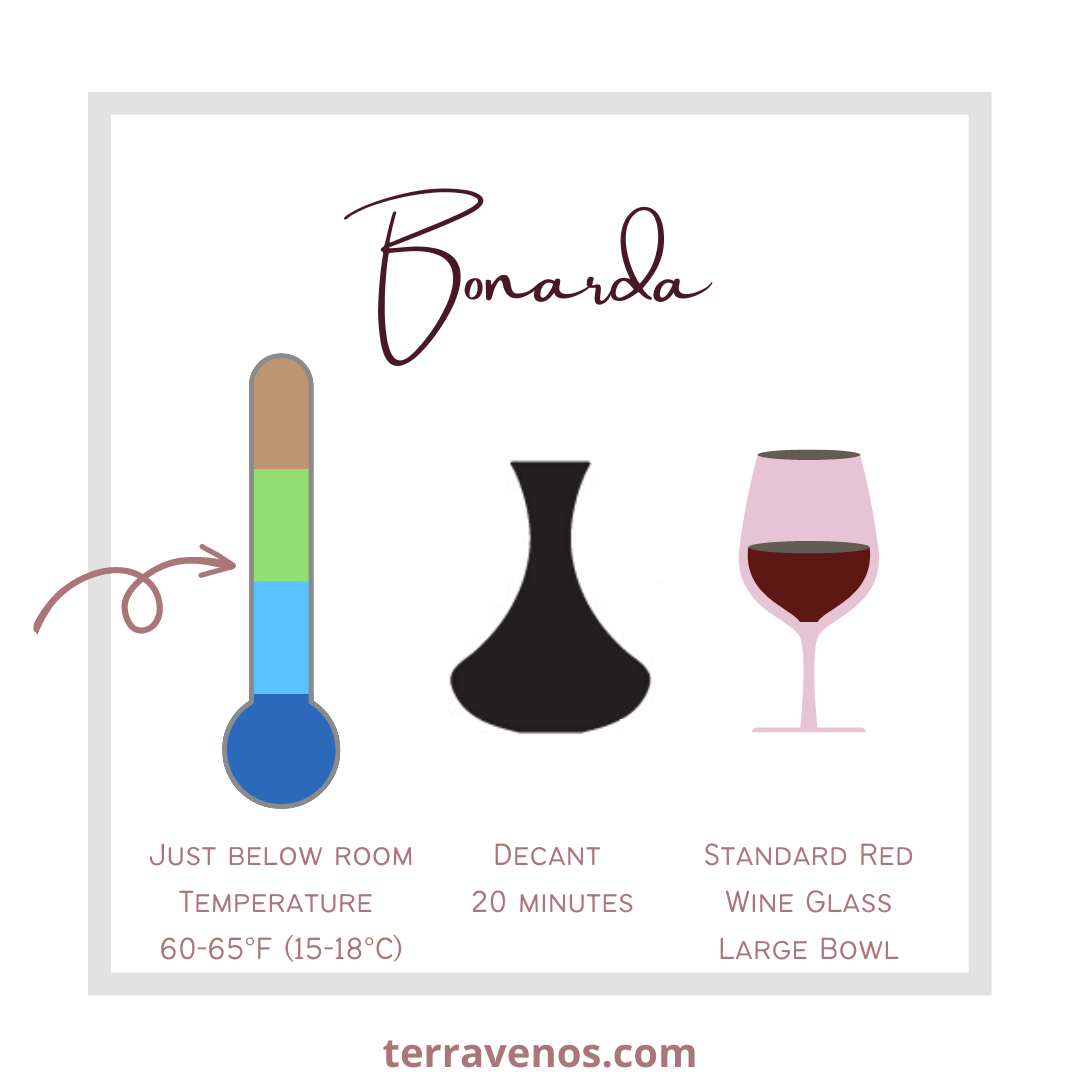
Temperature
Serve Bonarda slightly below room temperature, around 60-65°F (15-18°C). This allows the wine’s aromas to open up while maintaining a refreshing coolness.
Glassware
Select a standard red wine glass with a round bowl and a slightly tapered opening. This shape encourages aeration and concentrates the aromas, enhancing your tasting experience.
Decanting
Bonarda can benefit from some decanting, especially if it’s a richer and fuller-bodied expression. Pour the wine into a decanter and let it breathe for about 20 minutes before enjoying it.
Aging Potential
While some lighter and fruit-forward Bonarda wines are meant for early consumption, certain premium bottlings can age gracefully for 5-7 years or more. The aging process adds complexity, softens the tannins, and develops intriguing secondary flavors like leather and tar.
Bonarda Food Pairing Suggestions
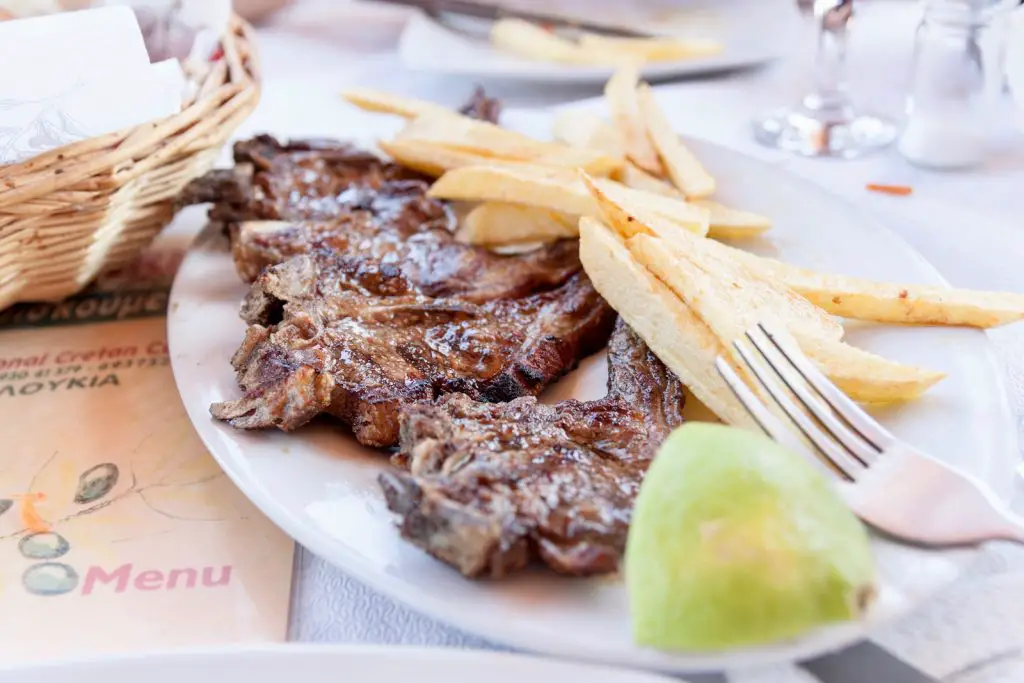
Bonarda’s moderate alcohol makes it a lovely wine for pairing with game meat, chicken, cheese, and seafood dishes in heavy sauces.
The wine’s vibrant acidity and robust structure can help cut through fatty and umami-rich dishes. Here are some quick pairings to consider.
Quick Tips: Bonarda Food Pairing
- Grilled steak with chimichurri sauce
- Empanadas filled with spiced ground beef and olives
- Eggplant Parmesan with tomato sauce and melted cheese
Helpful Tip: Still figuring out wine pairing? Head over to this post for a few quick pairing tips and tricks.
Notable Bonarda Producers and Bottles to Try

When exploring Bonarda, seek out wineries known for their dedication to crafting exceptional expressions of this grape. Argentina boasts a selection of outstanding producers to discover, and here are a few noteworthy names:
- Bodega Norton (Mendoza)
- Zuccardi Valle de Uco (Mendoza)
- Luigi Bosca (Mendoza)
These wineries offer a glimpse into the diverse styles and expressions that Bonarda can offer.
Fun Wine Fact: Bonarda is sometimes referred to as “Bonarda Argentina” to distinguish it from the Italian varietal of the same name.
Bonarda in the Vineyard

Bonarda/Douce Noir is renowned for being a late-ripening grape variety, often harvested after Cabernet Sauvignon. One of my favorite wine experts, Oz Clarke, highlights the significance of allowing a long growing season and ensuring full ripening of the grapes, as harvesting too early can lead to the development of undesirable green, vegetal flavors in the wines.
To extend the growing season and facilitate early bud break, some vignerons opt for early pruning in January.
This grape boasts thick skins and a high phenolic content, meaning it needs warmth to achieve physiological ripeness (ripeness of the flavors, not just the sugars). However, excessive heat can pose a risk of creating “cooked flavors” in the resulting wines.
In California, growers have identified warm-climate sites with significant diurnal temperature variations, featuring a drop in night time temperature, as more ideal vineyard locations for Douce Noir/Charbono.
Bonarada Synonyms
Alcantino, Aleante, Batiolin, Bathiolin, Blaue Gansfuesser, Bonarda, Bourdon noir, Carbonneau, Charbonneau, Charbono, Corbeau, Cot Merille, Cot Rouge Merille, Cote Rouge, Dolcetto Grosso, Dolutz, Douce noire, Folle Noire d L’Ariege, Grenoblois, Korbo, Mauvais noir, Ocanette, Picot Rouge, Plant de Calarin, Plant de Montmelion, Plant de Savoie, Plant de Turin, Plant noir, Turca, Turin and Turino
whew! this little grape has gotten around!
Final Thoughts – Bonarda as a Must-Try Red Wine Varietal
With its vivacious fruit flavors, pronounced structure, and the potential for aging, Bonarda is a wine that offers excellent value for quality. Here are three key takeaways to remember:
- Distinctive Fruit Profile: Bonarda showcases a delightful array of red fruit flavors, complemented by a touch of spice and herbs, creating a dynamic and engaging drinking experience.
- Versatility on the Table: Bonarda’s adaptability allows it to pair beautifully with a diverse range of dishes, from savory meats to flavorful vegetarian options.
- Argentinian Heritage: Embrace Bonarda as a true expression of Argentina’s winemaking prowess, celebrating its distinct personality that sets it apart from other red varietals.
Thirsty for More?
Head over to this post for a look at Malbec.
Love exploring red wines? Here are a few more strong red wines worthy of your time.
If you’re hosting a wine tasting, check out this list of cold appetizers for your next red wine tasting.



